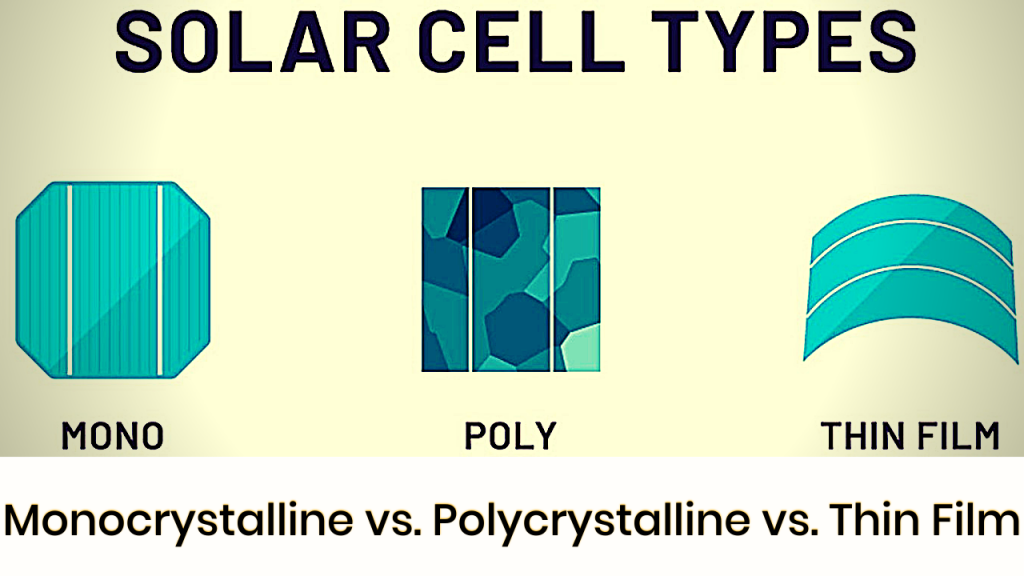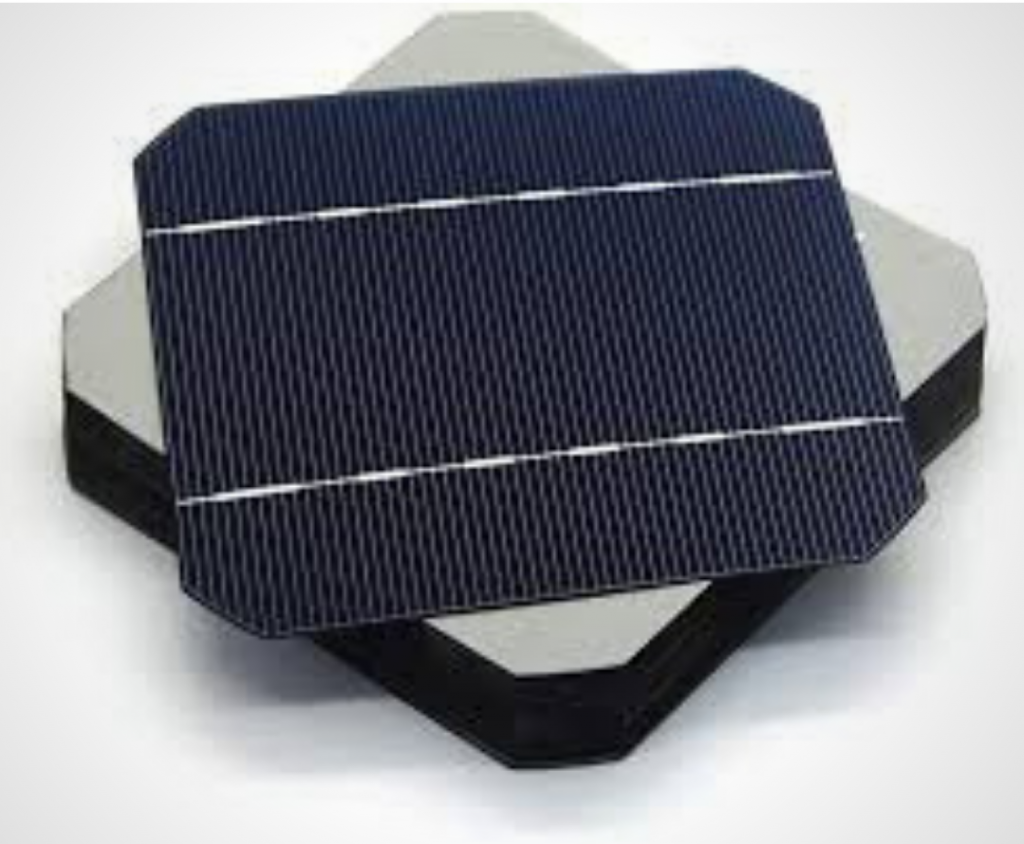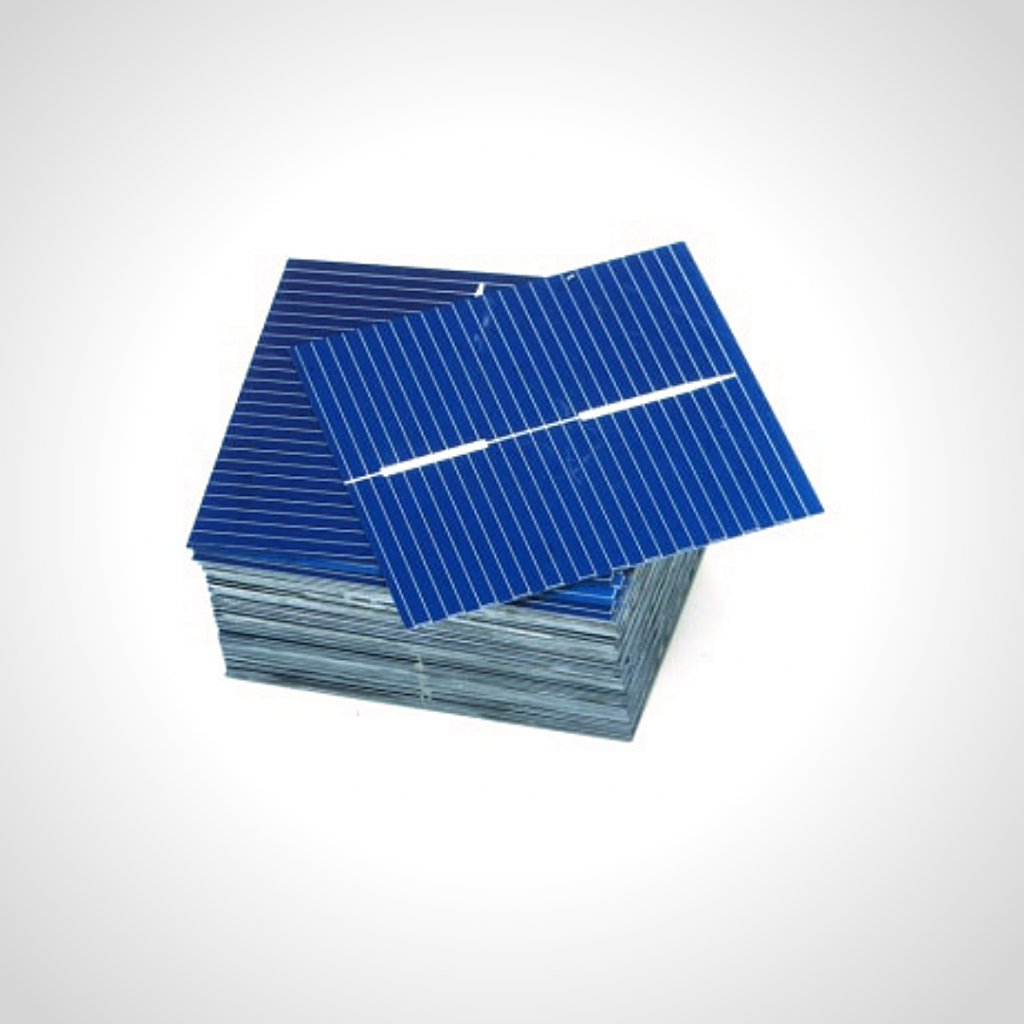Over the last two decades, the growth of solar (PV) panels has been astounding. As per NREL[1], from the different types of solar panels, the Crystalline Silicon (c-Si) solar panels, both Monocrystalline and Polycrystalline Solar panels, accounted for more than 96% of production in 2017; The growth is primarily driven by the countries trying to move to renewable sources of energy, combined with increased investments, government incentives in the renewable space which has led to a rapid decline in prices, that has to lead to increased adoption of solar by homeowners and businesses alike.

But, a common question that generally comes from homeowners or businesses alike is the difference between the different types of solar panels: silicon-based – monocrystalline vs. polycrystalline solar panels or thin-film solar panels. In today’s market, almost 99 % of the solar panels installed for residential or commercial purposes are MonoCyrstalline, Polycrystalline, or Thin Film Solar panels.
Although there is a handful of difference, all the types of solar panels manufactured today serve one primary function; To capture the sun’s energy and convert it into electricity. And they all are made from one common element, i.e., Silicon. Silicon is one of the most widely available elements in nature. According to Wikipedia[2], the Earth’s crust comprises silicate material and covers almost 90% of them, making Silicon the second most abundant element after Oxygen.
To understand more about the differences between the different types of solar panels, we need to dig deeper and understand the solar cells that make up the solar panels. Its characteristics make each solar panel expensive or look aesthetically pleasing or lightweight.
Monocrystalline Solar panels

Construction
Monocrystalline Solar panels are made from MonoCrystailline Cells which are in turn made from pure monocrystalline Silicon. Making monocrystalline or polycrystalline cells starts with extracting pure Silicon from Silica Sand. To make pure Silicon, the silica sand is melted to leave to get almost pure Silicon which is 99% pure but is not refined enough to make solar cells. The pure silica is then further purified by exposing it to HCL and hydrogen chloride in a reactor, and then the gas is cooled and liquified by distillation. Once the distillation process is over, the remaining silica is exposed to Hydrogen gas at extremely high temperatures and cooled. The Silicon at that point is 99.999% pure, which can be used to manufacture solar cells. This monocrystalline Silicon is made up of an ordered crystal lattice structure that is entirely solid and free of defects or impurities. This is where the similarities end for monocrystalline and polycrystalline solar cells.

Monocrystalline solar cell ingots are made using the Czochralski method[3]. The Czochralksi method is a process of obtaining a single crystal of semiconductor. This process was discovered by a Polish scientist named Jan Czochralski. He discovered by luck while he was investigating the crystallization rates of metals. According to this process, he manufactured a single crystal or a monocrystalline solid. This solid material was continuous and unbroken to the edges of the sample, with no grain boundaries. As a result, no defects were associated with that solid material, and it can give monocrystals their unique properties. As a result, the liquid Silicon will slowly solidify over, creating one big homogenous cylindrical crystal silicon, also known as silicon ingot. The Silicon ingot is then sliced using a wire saw, creating 1mm silicon wafers. Once that is done, the wafers are washed and polished to clean the dust, dirt, and scratches.
Performance
Monocrystalline Solar Panels have one of the highest efficiency among all the solar panels sold in the market. Because these cells have a single crystal structure, the electricity flow has minimal resistance. The monocrystalline silicon cells have been shown to have efficiencies of over 25% in lab settings. However, industrially produced solar modules have 18-22% efficiencies under STC.
Price
Monocrystalline Solar panels are the most expensive than any other solar panels. This is primarily due to its
Lifespan
Monocrystalline Solar Panels have a long lifespan. The solar panel manufacturers offer 25 years lifetime warranty on the solar panels.
Temperature Coefficient
As the surrounding environment’s temperature rises, the solar panels’ maximum output is directly affected. As solar panel temperature increases, its output current increases exponentially while the voltage output is reduced linearly. In Monocrystalline solar panels, the cells have a temperature coefficient of around -0.3% / C to -0.5% / C. That means, for every Celsius or 32 degrees Fahrenheit temperature rise, the monocrystalline solar cell will lose 0.3 to 0.5% efficiency as long the temperature rise.
Aesthetics
Monocrystalline Solar panels are uniform in appearance and have a solid black color.
Recyclability
Monocrystalline Solar panels are recyclable, but there is a caveat. The solar panels are made of 3 components, Glass, metal frame, and solar cell. The metallic and glass frame of the Solar panels are 100% recyclable. Solar cells made from Silicon are generally recyclable and should be inspected before they can be recycled. The wafers are generally melted and used again to manufacture new silicon solar modules, and almost 85% of the solar cells can be recycled.
Polycrystalline Solar Panels
Construction

Polycrystalline Solar Panels are made from multi-crystalline cells made from pure Silicon, just like monocrystalline solar cells are created. As with monocrystalline cell manufacturing, the Silicon is purified to the 99.9999% form. Unlike monocrystalline solar cell production, which requires ingot production using the Czochralski Process, the molten Silicon is left to cool and fragment. The fragments are combined into molten form and are cast into bars or ingots, which are then cut into thin wafers, polished, and after which they are assembled into cells. Hence, polycrystalline cells are cheaper because of the more straightforward manufacturing process.
Performance
The standard solar cell size for polycrystalline solar cells is 6 inches. Since different silicon solar fragments are combined, molted, and finally made into solar cells, the efficiency of these polycrystalline solar panels is lower than monocrystalline solar cells. The average efficiency of a polycrystalline solar cell is around 15%, but it hovers anywhere between 14-16%
Price
Due to the lower efficiency caused by the manufacturing process, which is much simpler than the monocrystalline solar, and the effect of the bluish tint, the price for polycrystalline solar cells is around $ 0.65/W
Lifespan
Polycrystalline Solar Panels have a long lifespan. The solar panel manufacturers offer 25 years lifetime warranty on the solar panels.
Temperature Coefficient
The cells have a higher temperature coefficient of 0.4 to 0.5% / C in Polycrystalline solar panels. That means, for every Celsius or 32 degrees Fahrenheit temperature rise, the polycrystalline solar cell will lose 0.4 to 0.5% efficiency as long as temperature rise.
Recyclability
Polycrystalline Solar panels are recyclable. The solar panels are made of 3 components, Glass, metal frame, and solar cell. The metallic and glass frame of the Solar panels are 100% recyclable. Solar cells made from Silicon are generally recyclable and should be inspected before they can be recycled. The wafers are generally melted and used again to manufacture new silicon solar modules, and almost 85% of the solar cells can be recycled.
Aesthetics
Polycrystalline solar panels are made by melting different silicon fragments and not using single-crystal silicon. As a result, the polycrystalline solar cells are speckled blue hue and may not be of everyone’s taste.

Thin Film Solar Panels
Thin-Film solar panels are used when looking for a less expensive option. These panels are manufactured by placing one or more films of silicon or cadmium, or copper photovoltaic material onto a substrate. The main reason why people prefer thin-film solar is
- easiest to produce and
- economies of scale
Hence, making them cheaper than the alternatives due to less material needed for their production.

Construction
Thin Film Solar panels are made from Thin-Film Solar Cells. These cells are manufactured on substrates like glass, ceramic, or metal. They are done by vaporizing and spraying (depositing) thin layers of semiconductor material. As a result, these thin-film solar cells are easy to manufacture and less costly than mono or polysilicon cells. One of the positive qualities of thin-film cells is that they can absorb light much better than mono or polycrystalline cells. These semiconductor cells are less than a micron (μm) in thickness. They are 100-1000 times less thick than a silicon wafer. Another reason why the manufacturing costs are low is the production unit, instead of being on a relatively small silicon wafer. Each thin-film solar panel layer is 1 micron thick, thinner than a human hair.
Types of Thin Film Solar Panels
The thin-film solar panels are the easiest to manufacture and can be made with different materials. As a result, there are three different types of thin-film cells.
- Cadmium Telluride (CdTe) Thin Film
- Copper Indium Gallium Selenide (CIGS)
- Amorphous Silicon (a-Si) thin Film
The Cadmium Telluride (CdTe) Thin-film is a thin-film PV technology based on Cadmium Telluride as the semiconductor layer used to absorb and convert sunlight into electricity. It is the predominant thin-film technology today and accounts for over half of the thin-film market. They are the lowest solar cells used today and have the shortest energy payback time than any other PV technology. First Solar, a US manufacturer in Tempe, Arizona, is the largest CdTe thin-film technology manufacturer. In 2019, the registered conversion efficiency in a lab setting was 22.9%
Copper indium gallium selenide (CIGS) thin film
A copper indium gallium selenide solar cell, also known as a CIGS cell, is a thin-film technology that converts sunlight into electricity. It is manufactured by depositing a thin film of copper, indium, gallium, and selenium on a glass surface. CIGS solar cells have one of the highest efficiency, around 21.7% for a lab setting, but 13.8% efficiency has been registered in the large area production panel in commercial production.
Amorphous silicon (a-Si) thin film
Amorphous Silicon (a-Si) solar cells are used as thin-film solar cells for Amorphous silicon (a-Si) thin-film solar panels. Those are deposited onto thin films and are generally low efficiency compared to Cadmium Telluride (CdTe) or CIGS thin-film solar panels. They are the most environmentally friendly PV technology in the market today since they don’t have any toxic heavy metals such as Cadmium or Selenide. The most notable use of the a-Si solar cell was the solar power calculator manufactured in the late 70s because the device required very little power. The average efficiency of amorphous silicon thin-film solar panels is around 5-7%, with the highest recorded at 12.24%.
Performance
Although the manufacturing costs are cheap for Thin Film Solar Panels, they have drawbacks that cannot be ignored. Although they can capture light more efficiently than crystalline solar panels, these thin-film solar panels have 7-9% efficiency. Although lab efficiencies of Cadmium Telluride (CdTe) and Copper Indium gallium diselenide (CIGS) have shown to exceed 21%, the average efficiencies of these solar panels are between 14-18%.
Temperature Coefficient
According to Wikipedia[4], the temperature coefficient is the relative change of a physical property with a temperature difference. Thin Film Solar Panels have a better Temperature Coefficient Ratio than your typical crystalline silicon solar panels. Thin Film Solar panels only lose a small portion of their efficiency when exposed to high heat. Hence thin-film solar panels can be used in extreme heat like deserts where temperatures reach 130F or higher.
Life Span
The average life span for Thin Film Solar Panels is around 10-20 years. They are comparatively less than the 25 -30 year lifespan offered by the crystalline silicon panels.
Cost
Thin-film solar panels are the cheapest compared to silicon crystalline panels. The reason for that is that these panels are generally made of Film in nature, and hence they need less material than Glass, and they are easier to manufacture.
When it comes to installation, these panels are easier to install because of their lightweight and flexibility, which results in lower costs.
Aesthetics
Thin-film solar panels can be recognized by their name itself, thin Film. The thin film thickness varies from a few nanometers to tens of micrometers and is 350 times thinner than silicon crystalline solar panels. Although being thin is a unique feature of thin-film solar panels, they are lightweight and flexible, making them helpful in building integrated photovoltaics and portable devices.
What’s our verdict between the types of Solar panels?
Increasingly, the quality and reliability of the manufacturer are far more critical when it comes to choosing the different types of solar panels than which of the two technologies is chosen. As explained by a previous blog post, this quality can usually be seen by the Tier level of solar panels. [5]

